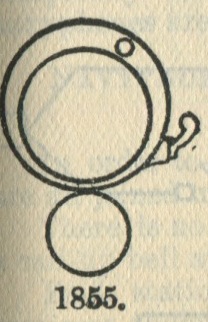Pattern 1855 Navyphone
As shown in Annual Report of the Torpedo School, 1902, when it was apparently a new model.
The Pattern 1855 Navyphone was an early example of Navyphone used in the Royal Navy, intended for use on upper decks. In modern parlance, it would be called an intercom. It first appeared around 1902 along with the Pattern 1856 Navyphone which was intended for use in engine rooms.[1]
Form Factor
The 1855 was bulkhead mounted in a cylindrical chassis, approximately 15cm across.[2] It had a push-to-talk lever marked Press whilst talking[3] (or Press whilst speaking[4]) on the right side and a speaking transmitter on its face. Like many navyphones, its speaker was inside and faced rearward; a metallic horn around 60mm at its mouth came out from beneath the chassis and projected the remote speaker's voice out to the local listener.
A call-up button on the left side[5] sufficed to ring the bell at both the local and remote terminals. It may have had a small call indicating lamp at the 1 o'clock position,[6] but the bells and the battery were not an integral part of the navyphone.
The transmitter was affixed by 3 screws and could be revolved (by rolling about its axis)[7] "to shake up the carbon granules."[8]
Like most navyphones before those used in Lord Nelson, Bellerophon and later classes, these phones were battery-powered in pairs off six pattern 1453 cells in a pattern 1704 battery box.[9] This box was separate.
See Also
Footnotes
- ↑ Annual Report of the Torpedo School, 1902, p. 60.
- ↑ estimating from Annual Report of the Torpedo School, 1902, Plate 25.
- ↑ Annual Report of the Torpedo School, 1902, p. 60.
- ↑ Torpedo Drill Book, 1914, p. 259.
- ↑ Annual Report of the Torpedo School, 1902, p. 60.
- ↑ Torpedo Drill Book, 1914, p. 259.
- ↑ Electrical Drill Book, 1924, p. 275.
- ↑ Torpedo Drill Book, 1914, p. 260.
- ↑ Torpedo Drill Book, 1914, p. 263.
Bibliography
